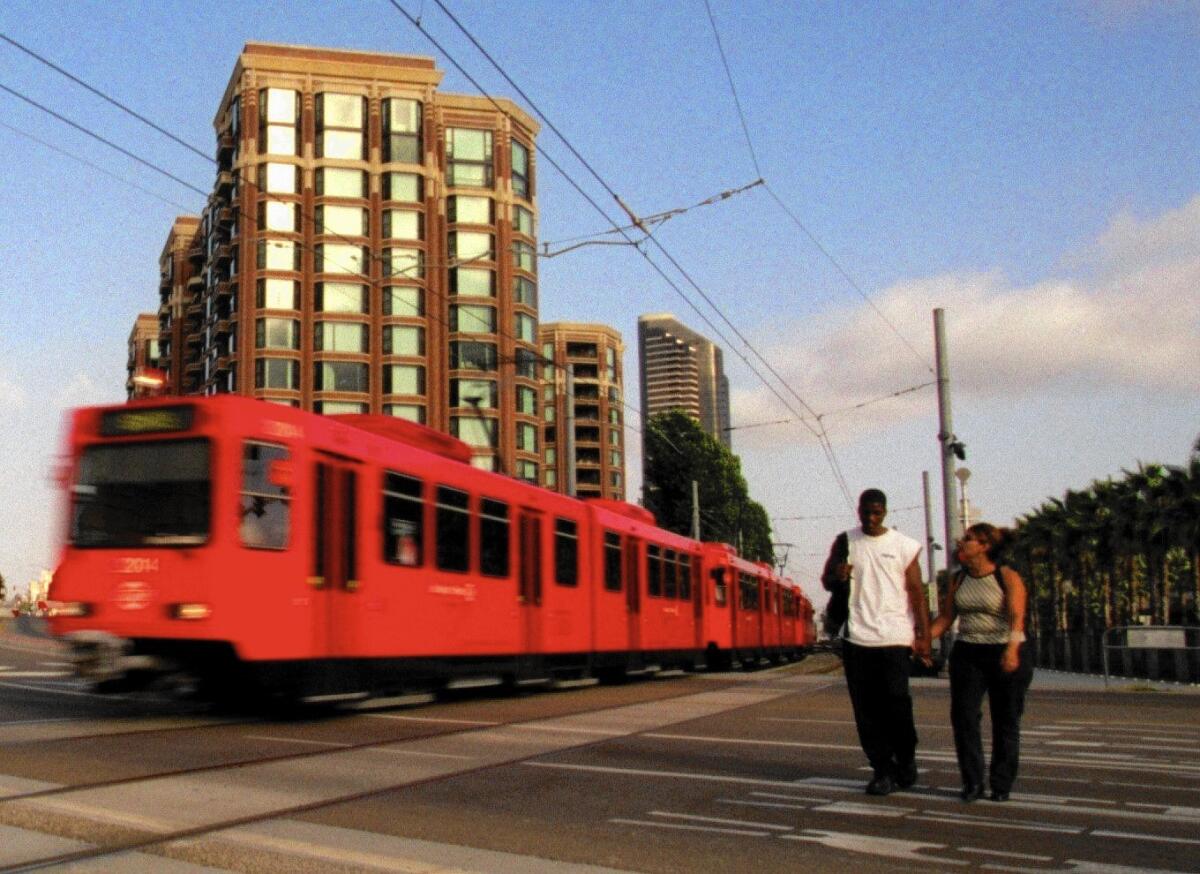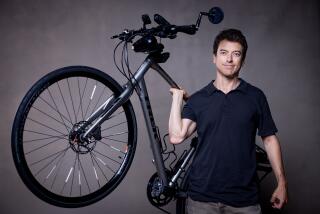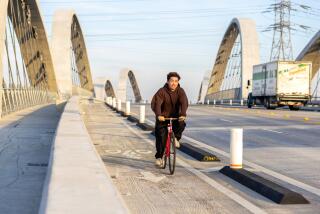San Diego planners envision skyways and light-rail stops in beach towns

reporting from san diego â The newest route to the beach might come with a birdâs-eye view and no risk of tracking sand into your car.
A new long-term blueprint from San Diego planners puts skyways and light-rail stations in some of the countyâs beach communities, making it possible for people who want to get to the ocean to make the trip from most of the county without getting behind the wheel.
Beach access is one of the many components of the San Diego Assn. of Governments plan that both reflects the countyâs growth trend and seeks to shape it.
SANDAGâs 35-year vision gives a framework for land use and transportation through the middle of the century. Drafters say it will guide the region as it adds an estimated 1 million people by 2050, and that many of its ideas will appear in the regionâs future in some form.
The blueprint is built on the assumption that suburban sprawl will be curtailed, and more people will live closer to where they work and along transportation corridors. There will be a significant shift in the number of households in multifamily homes. Neighborhoods will be more densely populated, and it will be easier to use mass transit like trolleys and skyway gondolas.
Past plans predicted that a third of the county would be left as open space, but now, forecasts show that 55% could be left as parks, protected habitat or farmland.
âWhat that means is that in the two or three decades before, where the region was stretching out, it kind of stretched to the limit now,â said SANDAG Executive Director Gary Gallegos. âNow what it is doing is growing up. The reason I think thatâs important is that as our transportation plans evolve, we need to take that into account.â
The plan envisions $204 billion in transportation spending, half of which would go to public transit like new light-rail lines, skyways and buses, the plan says. Some $42 billion would go toward highway construction, and in particular, managed lanes. Thereâs $5 billion to encourage biking and walking. The overall figure includes operating costs.
Most of the funds would come from the federal government and state, but 48% would come from local sources.
âIt does represent a very balanced approach to regional transportation needs,â said Jerome Stocks, former Encinitas mayor and former chairman of SANDAGâs board. The plan also predicts 53,000 new jobs per year and growth in the gross regional product of $13 billion.
The plan, especially for road improvements, depends on next-generation managed highway lanes and smart technology, as well as old-school car and van pools.
âI donât think that what the plan is suggesting is that weâre going to build a bunch of new roads, but given the lane-use patterns that we see, and how they overlay, that we can make smart investments, not in whole new freeways, but in extra lanes to increase efficiency and make San Diego an early adopter of new technology,â said Charles Stoll, SANDAGâs director of land use and transportation planning.
Managed lanes help traffic planners to get motorists to drive the way they want, hitting the proper mix of speed and distance between cars.
Managed lanes are a way to get people to use roads efficiently, Gallegos said. A smart system will consider the traffic up and downstream and change how cars are admitted onto the highway, and managed toll roads will change their prices to encourage or discourage people to use them and hopefully prevent traffic jams.
Around 100 miles of rail service â the driving distance from San Ysidro to Irvine â is rolling along.
The Coaster and Sprinter trains should both run on double tracks to increase service, and as many as four new trolley lines should also be built to link people to the regionâs job centers, according to the plan.
The Mid Coast Trolley could begin construction early next year and is a foundation for other new transit projects, including the skyways. The nine-stop extension of the Blue Line would go from the Santa Fe Depot downtown north to University City, to a University Town Center Transit Center.
A second new rail line would intersect the Mid Coast Trolley, and links Pacific Beach to Sorrento Mesa. A third line would replace a rapid bus route that stretches from San Diego State University, down El Cajon Boulevard, and down Park Boulevard heading downtown.
The fourth line would start at San Ysidro, go up the 805 Freeway to the 15 Freeway to Mission Valley. From there the line would run north to job centers in Kearny Mesa, and to Sorrento Valley.
Some trolley ideas might be derailed in favor of a more unique mass transit system. The plan suggests that skyways â overhead gondolas carried by a wire cable â could be better than trains in some cases.
Skyways are much cheaper than the cost of rail and can climb hills that are insurmountable with trolleys. Three routes are being considered.
NEWSLETTER: Get the dayâs top headlines from Times Editor Davan Maharaj >>
One line would connect Balboa Park to the waterfront convention center with possible stops along the way.
The second would go from Pacific Beach to Sorrento Mesa. Gallegos said the steep grades would require expensive tunnels and bridges to run a trolley inland, so skyways might be cheaper.
The third route would extend from University Town Center â home to a new Blue Line stop â to the Coaster, with stops along the way. This would link the two systems and give train riders new options, Gallegos said.
âI think our goal has been to provide competitive mobility options for San Diegans, and that they are smart and will pick things that make their life better,â he said.
Bikers and walkers would get a $5-billion boost under the plan.
The bike network would extend through the entire county and nearly every coastal part of the region, as well as downtown, UTC and Sorrento Valley.
It should help the city get closer to having 6% of the population commuting by bike by 2020, and 18% by 2035, said Andy Hanshaw, executive director of the San Diego County Bike Coalition.
Some critics say itâs folly to think such a large portion of people commuting would do so on bikes. Advocates have their own criticism: They say thereâs no way the city can reach its goals unless the SANDAG plan seriously bolsters resources for bicycle travel.
There should be protected bike lanes, traffic control projects and other efforts that convince people that they wonât get hurt while riding a bike, Hanshaw said. Ensuring a safe commute is the best way to convince people to get in the saddle, followed by education programs that extol the health and environmental perks of riding, he said.
âMostly itâs going to take safe infrastructure,â he said. âAt the same time, education and encouragement programs that need to be implemented are implemented.â
Critics and fans will have a final chance to give their opinion on the plan when it goes before the SANDAG board Oct. 9. Even still, the plan isnât binding, and officials said the future will certainly deviate from their drafts.
Joshua Stewart writes for the San Diego Union-Tribune.
ALSO
Why 18 Orange County kindergartners are learning Vietnamese and English
Junipero Serra statue at Carmel Mission vandalized days after he was made a saint
At 50, UC Irvine has built its campus culture from the ground up
More to Read
Sign up for Essential California
The most important California stories and recommendations in your inbox every morning.
You may occasionally receive promotional content from the Los Angeles Times.










